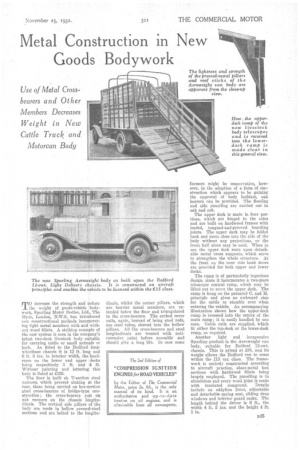Metal Construction in New Goods Bodywork
Page 63

If you've noticed an error in this article please click here to report it so we can fix it.
Use of Metal Crossbearers and Other Members Decreases Weight in New Cattle Truck and Motorvan Body
MO increase the strength and educe the weight of goods-vehicle bodywork, S purling Motor Bodies, Ltd, The Hyde, London, N.W.9, has int duced new constructional methods inco orating light metal members with and without wood fillets. A striking exam le of the new system is seen in the corn any's latest two-deck livestock body s itable for carrying cattle or small anim s or both. As fitted to the Bedford longwheelbase chassis it is 12 ft. Ion and 6 ft. 8 ins, in interior width, the headroom on the lower and upper decks being respectively 2 ft. and 4 ft. Without painting and letterin i this body is listed at £125.
The floor is built oh T-sectio steel runners, which prevent sinking t the rear, these being carried on boxction steel cross-bearers of bridge-typ construction ; the cross-bearers re t on oak runners on the chassis be' gitudinals. The vertical side pillars if the body are made in hollow presse i-steel sections and are bolted to the lo gitu
dinals, whilst the corner pillars, which are heavier metal members, are extended below the floor and triangulated to the cross-bearers. The arched cover rails, again, instead of being steel rods, are steel tubes, sleeved into the hollow pillars. All the cross-bearers and steel longitudinals are treated with anticorrosive paint before assembly and should give a long life. In case some farmers might be conservative, however, in the adoption of a form of construction which appears to be gaining the approval of body builderk, oak bearers can be provided. The flooring and side panelling are carried out in oak and ash.
The upper deck is made in four portions, which are hinged to the sides and are built on hardwood frames with leaded, tongued-and-grooved boarding joints. The upper deck may be folded back and nests close into the side of the body without any projections, or the front half alone may be used. When in use the upper deck rests upon detachable metal cross supports, which serve to strengthen the whole structure. At the front on the near side lamb doors are provided for both upper and lower decks.
The ramp is of particularly ingenious design, since it incorporates a two-piece telescopic central ramp, which may be lifted out to serve the upper deck. The ramp is hung on the patented C. and M. principle and gives no awkward step for the cattle to stumble over when entering the vehicle. An accompanying illustration shows how the upper-deck ramp is recessed into the centre of the main ramp ; it is easily handled by one man. Guide rails are supplied, which fit either the top-deck or the lower-deck ramp, as required.
Another light and inexpensive Spurling product is the Aeroweight van body, suitable for Bedford 12-cwt. chassis. This is priced at as, and its weight allows the Bedford van to come within the £15 tax class. The framework is entirely constructed according to aircraft practice, sheet-metal box sections with hardwood fillets being largely employed. The panelling is in aluminium and every wood joint is made with insulated compound. Details include an eddyfree front, adjustable and detachable spring seat, sliding drop windows and interior guard racks. The length behind the driver is 6 ft., the width 4 ft. 5 ins, and the height 4 ft. 1 in.




































































































